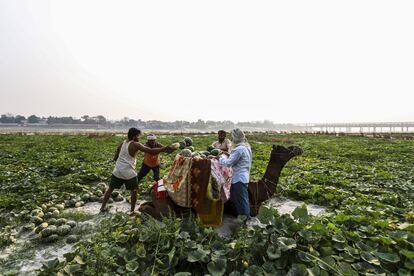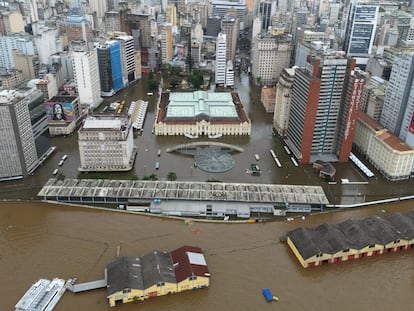Humanity has altered the circle of life of the planet’s rivers
Higher temperatures and excess fertilizers have disrupted the rate of decomposition of organic matter in waterways

Life in rivers is changing. The rate of decomposition of the organic matter in rivers and streams is being disrupted by the increase in temperature and the greater availability of nutrients. Using canvas (the kind used by painters), hundreds of scientists have measured the rate at which plant debris degrades in more than 500 waterways on six continents. In addition to achieving a standard and valid method for the entire planet, the authors of this enormous research have detected the global patterns by which the carbon present in leaves and other plant residues is released into the atmosphere in the form of CO₂ or is trapped at the bottom of lakes and seas that meet rivers. The former pathway accelerates climate change, the latter helps slow it down.
If the seas are the arteries of the planet’s circulatory system, the rivers are its capillaries. Enormous amounts of organic matter — an estimated 720 million tons per year — reach rivers from terrestrial ecosystems. This plant debris has several destinations on its way to the sea. A lot of it is incorporated in the microorganisms that degrade it, in the microbes that feed on the remains of plants and form the base of the food chain, of the circle of life. As plant compounds degrade into their essential components — a process called catabolism — a large part is released into the atmosphere as carbon dioxide or as methane, a greenhouse gas that is a lot worse than CO₂.
A third of these millions of tons ends up trapped where rivers end their journey, such as floodplains, lakes and oceans, where it remains for decades, centuries or millennia. The distribution depends on the rate of decomposition; the faster it is, the lower the percentage that is trapped and mineralized. But measuring the rate of decomposition and doing so in a universal and comparable way seemed impossible. It involves dozens of factors that are highly dependent on local conditions, from the acidity of the soil and the temperature to the leaf characteristics and existing microorganisms. Now, more than 800 experiments in hundreds of waterways have found, first, a model to predict the decay and then, with it, the global patterns that govern it. And the researchers have released the model so that other scientists in their field can use it.
Of the more than 100 variables measured in the work, which was published in Science, the researchers verified that temperature and nutrient availability are among those that most critically affect the speed of decomposition. “Temperature has a direct effect on microbial decomposition, more or less, as predicted by the metabolic theory of ecology,” recalls Luz Boyero, from the Department of Plant Biology and Ecology at the University of the Basque Country in Spain, who is a co-author of the research. The thermal variable could explain the main global pattern observed: the rate of organic decomposition increases as latitude decreases. Hence, the highest rates of degradation have been found in Central America, Western Africa (through which the Congo River flows) and Southeast Asia. “But the relationship with total decomposition is not so direct,” adds Boyero. What they have observed is that while the average air temperature does not seem to change the rate of degradation, it is impacted by water temperature.
Another critical variable is the presence of nutrients. “Cellulose is basically carbon, but in order to degrade it, microorganisms need other elements not present in plants, such as nitrogen or phosphorus,” explains Antonio Camacho, professor of ecology at the University of Valencia in Spain, whose research team participated in the study, providing data from Iberian rivers in the Mediterranean basin and from Antarctic water courses. Much of the green revolution of the last century and the continuous rise in agricultural production is due to the use of fertilizers. But many of them end up in rivers or lakes and change the microscopic ecosystems in a process known as water eutrophication, which has become a global threat. Camacho’s team went to the headwaters of the rivers to isolate the natural presence of nutrients from the anthropogenic one. “In this way, we have been able to determine that the availability of elements such as nitrogen or phosphorus is critical for the decomposition rate,” concludes the professor.
Although many other elements are involved, the human impact via fertilizers could explain some results of the work. The area of the great lakes of North America and the rivers of central Europe, being in mid-latitudes, degrade organic matter at almost the same rate as the Congo River or the Ganges, considered one of the most degraded on the planet. Meanwhile, the large Amazonian bodies of water, such as the Orinoco or the Amazon, have comparatively lower ratios. What do the Danube and the Brahmaputra have in common? They run through densely populated areas, maintained by agriculture that heavily uses fertilizers. The geographical pattern is also seen in higher latitudes. The rivers of Canada, the Nordic countries and, to a lesser extent, those of Siberia, degrade organic matter at a very slow rate, only surpassed by that observed by Camacho’s team in a watercourse on the Antarctic island where one of their bases is located.
The study was carried out by hundreds of scientists using canvas. “It is a standardized material, with a set cellulose percentage and fabric tension,” says Camacho. Canvas is made with cotton fibers, rich in cellulose, the vegetable polymer most present in plants. Using it, scientists were looking for a standard method that would be valid for the entire planet and independent of local variables. “We determine the decomposition rate with the loss of tension in the strips, an indication that the cellulose is degrading,” explains Camacho. The main product of this degradation is carbon. By repeating these experiments with leaves of 35 plant genera (coupled with previous data from local studies) the researchers were able to validate this cellulose-based method to predict the decomposition rate of almost any river.
The director of the Catalan Institute for Water Research (ICRA), Vicenç Acuña, points out that “trees are a CO₂ sink, their wood retains carbon for centuries, but there are also the leaves.” A good part of leaf litter ends up in the rivers, either because they are deciduous or due to their natural renewal. “It was believed that most ended up in other carbon sinks, such as the bottom of lakes and oceans,” he adds. “But now we know that it decomposes in rivers and the carbon reaches the atmosphere, feeding back into climate change.” For Acuña, the biggest contribution of the new study is that it has found a model to predict the pace of this process in practically all rivers.
David Costello, from Kent State University, who also authored the study, points out another impact of these changes, explaining that “faster decomposition in rivers means more CO₂ returns to the atmosphere rather than moving downstream to lakes, estuaries and oceans, where it could potentially become buried and stored long-term.”
Sign up for our weekly newsletter to get more English-language news coverage from EL PAÍS USA Edition
Tu suscripción se está usando en otro dispositivo
¿Quieres añadir otro usuario a tu suscripción?
Si continúas leyendo en este dispositivo, no se podrá leer en el otro.
FlechaTu suscripción se está usando en otro dispositivo y solo puedes acceder a EL PAÍS desde un dispositivo a la vez.
Si quieres compartir tu cuenta, cambia tu suscripción a la modalidad Premium, así podrás añadir otro usuario. Cada uno accederá con su propia cuenta de email, lo que os permitirá personalizar vuestra experiencia en EL PAÍS.
¿Tienes una suscripción de empresa? Accede aquí para contratar más cuentas.
En el caso de no saber quién está usando tu cuenta, te recomendamos cambiar tu contraseña aquí.
Si decides continuar compartiendo tu cuenta, este mensaje se mostrará en tu dispositivo y en el de la otra persona que está usando tu cuenta de forma indefinida, afectando a tu experiencia de lectura. Puedes consultar aquí los términos y condiciones de la suscripción digital.
More information

How climate displacement is affecting southern Brazil
Archived In
Últimas noticias
Most viewed
- Reinhard Genzel, Nobel laureate in physics: ‘One-minute videos will never give you the truth’
- Oona Chaplin: ‘I told James Cameron that I was living in a treehouse and starting a permaculture project with a friend’
- Pablo Escobar’s hippos: A serious environmental problem, 40 years on
- Why we lost the habit of sleeping in two segments and how that changed our sense of time
- Chevy Chase, the beloved comedian who was a monster off camera: ‘Not everyone hated him, just the people who’ve worked with him’










































